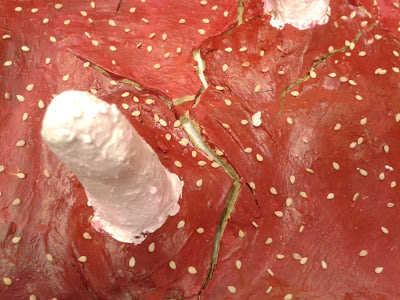I am writing this post through an understanding of Prasad Shetty's paper (the title of which I forget) on the mishandling of the city of Mumbai. Shetty argues (hints?) that the existence of multiple agencies, each which have their own interests and procedures of working in the city layer themselves upon each other, entangling them into a messy condition. Further, the non communication or the mis-communication between these agencies worsens the ways in which gaps are enlarged between the desired and the delivered product. Also, aspirations of different agencies are different and driven through a variety of forces, which are ultimately controlled or subjected through an altogether separate governing body which comprehends, schedules, funds and disseminates them, creating larger distortion.
Wondering of the condition of Academy of Architecture, I began thinking of it as sets of people (which could be analogical to the agencies above). Talking of condition, the question is why doesn't Academy function as it should or why is it not able to produce the kind of output it can / is capable of. One can locate / try to locate the problem at two levels - the scale of the institution as a set of functioning teams an the other at the level of the individual within these teams (if we may begin to call them so - teams of individuals - or sets of individuals).
To begin with finding issues with the teams, one sees that the academy does not really have a vision - a vision for its students, for its intellectual future. This leads to different sets of people forming their own micro visions which may not necessarily be converging, although which may overlap. I would specifically like to point out a few distinct sets that exist meanwhile:
- the management (the funding team/team who has financial control/the fuel of the institute),
- the permanent faculty team (the intellectual team/team which drives the institute/the engines of the institute),
- the visiting faculty team (the wheels of the institute),
- the non teaching administrative staff (the lubricants of the system), and finally
- the students (of course the consumers of the institute).
The students come with an extremely glorified image of the institute - an image which to a large extent may remain true, but muddled when one sees the Academy having complexities of space, infrastructure, people, etc. However, as students get consumed in the course, they realize the problems with the course itself. Through their own limited imagination(s), they try to problematize the academic trauma, which always ends up in pointing out the resource crisis. The visiting teaching staff have their own agendas and come from different schools of thought. Old, new, young, open, conservative, philosophical, professional, academic, theoretical, technical - all kinds of teachers do all kinds of things trying to reach at a common goal, which seldom is achieved. Within their subjects they have their own visions and aspirations. Some crave for newness, others to maintain minimum required standards. What else shall one expect of mass education?
The permanent staff comprises of a range of people whose objectives are misplaced. Some look at the institution as a place of work, some as a place to spend time in, others look at it as a place to educate, teach and learn. The least common denominator for such cross overs is to abide by the University syllabus. On the extreme end, the heads envision a large academic change, where they are unable to locate Academy in the larger picture, and further unable to locate a position for the student in the academic sphere. Meanwhile they struggle between revising curriculums, revising faculty attitudes, student attitudes, course structures and all possible things related to architecture education.
Lastly, the non teaching staff have their own dynamic politics with the management, faculty and students. The largeness institution that increases the presence of this set in number, makes it a powerful body which creates micro-politics of information-dissemination between students, faculty and perhaps management. Taking advantage of the lack of resources, scrutiny and loose system, they manipulate things in their own ways. The management is the supreme - which decides the fate of every thing that exists on the premises. It's agenda is to make Academy a mega institution which sets the cycle of making money and introducing new courses. the management, as it appears, consists of capitalistic, short sighted individuals who have not been able to formulate a vision beyond the banyan tree.
These different imaginations produce a lot of friction when various sets interact inevitably with each other. Where does an academic locate oneself in such a web - one questions. Further, what possible future shall we imagine of this institution? What future does one foresee of oneself with this institution - an institution which shall take perhaps 50 more years to find the right people and system to resolve its web of complexities? Rohan Shivkumar always says that every Institution goes through this phase of deterioration, giving the example of JJ College of Architecture, which today almost rots in the ideologies of archaic individuals; the physical space also speaks of it - the large BMC garbage can that welcomes you to an old grey building...
Academy meanwhile plans to just facelift itself. It's high time it gave itself booster injections and some internal nourishment so that it grows. Or else, I just proposed to one of my colleagues: the Banyan must be stripped of its leaves - it needs new ones.
Academy meanwhile plans to just facelift itself. It's high time it gave itself booster injections and some internal nourishment so that it grows. Or else, I just proposed to one of my colleagues: the Banyan must be stripped of its leaves - it needs new ones.





































